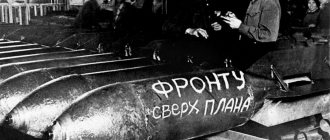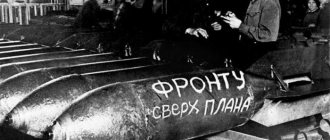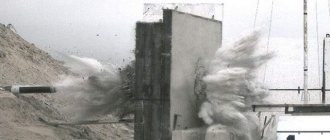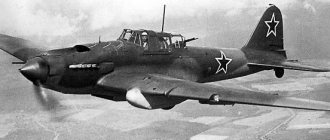Home page » Top 10 Most Powerful World Nuclear Bombs
ArmamentSociety
Evgeny Podolsky
Atomic weapons are rightfully considered not only the most terrible, but also the most majestic invention of mankind. It contains so much destructive power that the blast wave sweeps away not only all types of life, but also any, even the strongest, structures from the face of planet Earth. There are so many nuclear weapons in Russia’s military storage facilities alone that their simultaneous detonation could lead to the destruction of our planet.
And this is not surprising, since Russian reserves are in second place after American ones. Such representatives as “Kuzka’s Mother” and “Tsar Bomba” are assigned the title of the most powerful weapon of all time. The TOP 10 lists the nuclear bombs around the world that have or had the greatest potential. Some of them were used, causing irreparable harm to the ecology of the planet.
Foreign-made penetrating aerial bombs (2020)
V. Zubrov
In foreign countries, there are military installations such as command centers, ammunition depots and research laboratories that are of strategic importance for warfare, which are difficult to hit with conventional aerial bombs. They are mostly found underground, are not easy to detect and extremely difficult to destroy. To destroy such targets, penetrating aerial bombs are used (another name is concrete-piercing bombs), which are being developed by a number of foreign countries. They are able to penetrate deep into the ground or overcome several reinforced concrete floors before exploding. In this regard, special attention is paid to both improving existing and developing new penetrating bombs (PB).
In the USA, Israel and Turkey, several samples of PB have been developed and put into service to destroy well-protected underground objects.
BLU-109/B
. The air bomb has been in service since 1990 in the armed forces of the USA, Canada, France, Great Britain, Denmark, Belgium, Saudi Arabia, the UAE and other countries. The American Air Force uses the BLU-109/B modification, which uses the explosive “tritonal” (weight 243 kg), which is a mixture of TNT (80%) and aluminum powder (20%). In aviation, the Navy uses the BLU-109A/B modification with the PBXN-109 explosive (weight 238 kg) that is less sensitive to impact and heat. There is also a model BLU-109C/B with an AFX-757 BB. The wall thickness of the bomb body, made of high-strength steel, is 25.4 mm. To detonate a bomb, the FMU-143/B fuse of various modifications is used.
The BLU-109/B aircraft bomb is used as a warhead (warhead) of the GBU-10, GBU-15, GBU-24, GBU-27, GBU-31 guided aircraft bombs and the AGM-130 guided aircraft missile. When installing a wing kit on the UAB GBU-31, its flight range can reach 75 km when dropped from a height of 12 km. The Air Force is procuring 4,230 BLU-109/Bs in FY 2022 at a cost of $146.6 million. An additional 2,000 units are planned for fiscal year 2021 at a cost of $69.5 million.
BLU-118/B
is a modification of the BLU-109/B aerial bomb, adopted for service in 2001. The explosive used is PBXIH-135 (weight 254 kg), the main damaging factor of which is high overpressure. Having reached the affected area, the warhead is initiated with the formation of an aerosol cloud, which is detonated with some delay necessary for the uniform distribution of the aerosol mixture. The resulting high-pressure area effectively affects enemy personnel, freely penetrating into areas inaccessible to fragmentation ammunition. To detonate the warhead, the FMU-143J/B fuse is used with a delay of 120 ms.
BLU-137/B
. The aircraft bomb will be put into service in 2022. It has improved lethality and will replace the outdated BLU-109/B bomb. In fiscal year 2022, the US Air Force will purchase 1,000 of these bombs at a cost of $32.3 million. An additional 1,000 units are planned for FY 2022 at a cost of $50 million.
BLU-110/B
. For US Navy aviation, on the basis of the Mk83 high-explosive fragmentation bomb of 1,000 lb caliber, thanks to a decrease in the mass of the explosive and an increase in the thickness of the body walls, the BLU-110/B penetrating bomb was created, which uses the PBXN-109 explosive weighing 190 kg. The aircraft bomb is used as a warhead on the UAB GBU-16hGBU-32.
BLU-111/B
. For the AGM-154C guided aviation cluster, based on the Mk82 high-explosive fragmentation bomb of 500 lb caliber, the BLU-111/B penetrating bomb was developed, which uses PBXN-109 or AFX-795 explosives weighing 80 kg.
The Air Force will purchase 2,500 BLU-111/Bs in FY 2022 at a cost of $103.8 million. An additional 1,150 units are planned for fiscal year 2022 at a cost of $45 million.
BLU-113/B
. The aircraft bomb was put into service in January 1991. Its body is an artillery barrel of a decommissioned M201 self-propelled gun. The nose of the bomb was taken from BLU-109/B. It uses a Tritonal explosive weighing 299 kg.
The BLU-113/B air bomb is used as a warhead for the GBU-28, GBU-37 UAB. BLU-122/B. Under the P3I (Pre-Planned Product Improvement) program, the BLU-113/B aerial bomb was modernized. The new modification received the designation BLU-122/B, the body of which is made of high-strength steel ES-1. It uses AFX-757 explosives weighing 354 kg. The bomb has improved survivability and penetration characteristics. The wall thickness of the VSh-113 case is 57.9 mm, and the BLU-122 case is 44.5 mm.
Air bomb BLU-122/B
used as a warhead for the UAB GBU-28. The main carriers are the F-15E (2 AB) and B-2A (8 AB) aircraft. The initial batch was 350 units.
BLU-116/B
. In the early 2000s, the US Air Force adopted the BLU-116/B aerial bomb, developed by . Its body is made of nickel-cadmium alloy with the addition of depleted uranium. PBXN-109 is used as an explosive, but its quantity is reduced to 109 kg. FMU-157/B or FMU-159/B HTSF fuses are used for detonation. According to preliminary estimates, 2,800 units could be purchased by 2022.
The BLU-116/B air bomb is used as a warhead for the GBU-24, GBU-34 and AGM-86D CALCM missile launchers.
| Table 1 Main performance characteristics of penetrating bombs | ||||||||
| Characteristics | BLU-109/B | BLU-110/B | BLU-111/B | BLU-113/B | BLU-122/B | BLU-116/B | MRP-500 | NEB |
| Length, m | 2,503 | 1,85 | 1,54 | 3,91 | 4,04 | 2,4 | 1,4-1,5 | 2,6 |
| Case diameter, m | 0,368 | 0,356 | 0,273 | 0,368 | 0,387 | 0,68 | 0,273 | 0,457 |
| Weight, kg | 883-907 | 450 | 235 | 2002 | 2020 | 874 | 230 | 870 |
| Depth of penetration into concrete (into the ground), m | 1,8-2,5 | 1,8-2,0 | 1,5 | 6 (30) | 7 | 3,4 | 1 | 2,1 |
Guided aerial bomb GBU-57A/B MOR
. Developed in 2004. After successful flight tests (2008-2010), it entered service with the US Air Force in 2012. From 2009 to 2012, under contract, she integrated this bomb with the B-52N and B-2A bombers. In January 2012, the US Air Force had 20 units in service. The cost of the entire program to create the GBU-57A/B UAB was $400 million.
| Table 2 Financing of US Department of the Air Force programs to improve the UAB GBU-57 MOR (millions of dollars) | |||||||
| 2016 | 2017 | 2018 | 2019 | 2020 | 2021 | 2022 | 2023 |
| 39,7 | 3,6 | 38,4 | 38,1 | 0 | 0 | 0 | 0 |
The GBU-57A/B MOR guided aerial bomb is designed to destroy well-fortified deep bunkers and underground tunnels. The BLU-127/B bomb is used as a warhead. The UAB is equipped with a guidance kit, including the INS and PS CRNS "Navstar", a cruciform wing and lattice-shaped tail rudders. The body is made of special alloy steel (patent No. US 8414713 B2 “High Strength Military Steel” dated 04/09/2013). Compared to UAB GBU-28, the penetration capacity of GBU-57A/B has increased, according to preliminary estimates, by 10 times - up to 60 m (reinforced concrete capable of withstanding a pressure of 34,450 kPa). When a warhead is detonated, destruction occurs in a circle with a diameter of 30-35 m. To suspend the bomb in the bomb bay of the B-2A aircraft and when dropping it, special suspension equipment is used, the development cost of which was $12.1 million. Ammunition: two UAB GBU-57A/B.
| Table 3 Main performance characteristics of UAB GBU-57A/B MOR (according to preliminary assessment) | |
| Bomb length, m | 6,227-6,317 |
| Diameter, m | 0,8 |
| Wingspan, m | 1,5-1,7 |
| Guidance system | INS+PS CRNS "Navstar" |
| Warhead type | high explosive |
| Warhead mass, kg | 12 521-13 620 |
| Explosive mass, kg | 2 600-2 700 |
| Penetrating ability, (m): | |
| reinforced concrete (withstands pressure 34,450 kPa) | 60 |
| reinforced concrete (withstands pressure 68,900 kPa) | 8 |
| KVO | 3-6 |
From April 2012 to March 2014, the GBU-57A/B UAB was modernized under a contract worth $98.8 million. Thus, work was carried out to ensure the reliability of bomb fuses, improve the design of the tail rudders and increase the noise immunity of the Navstar CRNS substation. For test purposes, five bombs were dropped from a B-2A aircraft, and two explosions were carried out on the ground.
After 2014, work on modernizing the GBU-57 UAB continued: two modifications were carried out under the ETR-III and ETR-IV programs.
In February 2018, the US Air Force command signed a contract with the Boeing Corporation worth $21 million for the production of a new batch of UAB GBU-57D/B MOR of the latest modification, which differs from the first. In April 2022, the delivery completion dates were changed - from July 2020 they were postponed to July 2023.
In October 2022, the US Air Force signed a contract worth $90 million with two and Illwood National Forgs (both USA) for the production of the BLU-127/B PB. They will be part of the UAB GBU-57E/B, which entered service in 2016. According to preliminary estimates, the new modification has improved penetration characteristics (up to 80 m) and increased explosive mass.
MPR-500.
In February 2012, the MPR-500 penetrating bomb entered service with the Israeli Air Force. This is a 500 lb (227 kg) caliber ammunition capable of destroying concrete floors up to 1 m thick or piercing up to four concrete floors each 200 mm thick (80° impact angle, 330 m/s speed). When a bomb explodes in an open area, up to 26 thousand fragments are formed, which hit targets at a range of 60-100 m.
The MPR-500 aircraft bomb can be equipped with a guidance kit based on Navstar CRIS signals or with laser guidance.
NEB.
This penetrating bomb was adopted by the Turkish Air Force at the beginning of 2016. In its geometric dimensions, interface systems, weight and other characteristics, it is identical to the Mk84 aerial bomb (USA). The ammunition consists of two parts: a preliminary shaped charge containing PBXN-110 explosive, and a smaller caliber penetrating bomb containing PBXN-109 explosive. The second warhead is detonated approximately 1 s after the precharge is triggered.
The main carrier of the NEB bomb is the F-4E/2020 fighter-bomber. It can be equipped with sets with laser guidance "Lgk", as well as with INS/KRNS "Navstar" made in Turkey.
Thus, the development of aviation penetrating (concrete-piercing) bombs has been carried out in many countries around the world over the past few years. With the help of such weapons you can destroy underground bunkers and tunnels, command posts, research laboratories or warehouses of a potential enemy. The United States, Israel and Türkiye are most actively developing ammunition of this type. In the USA, obsolete BLU-109 bombs are being replaced with more modern BLU-137. The improvement of the most powerful UAB GBU-57 MOR continues, which to date has already undergone four upgrades to improve hit accuracy, noise immunity, destructive power and reliability of fuses. As of January 2012, the US Air Force was known to have at least 20 GBU-57 MOP UABs in service.
Foreign military review. - 2022. - No. 5. — P. 65-69











